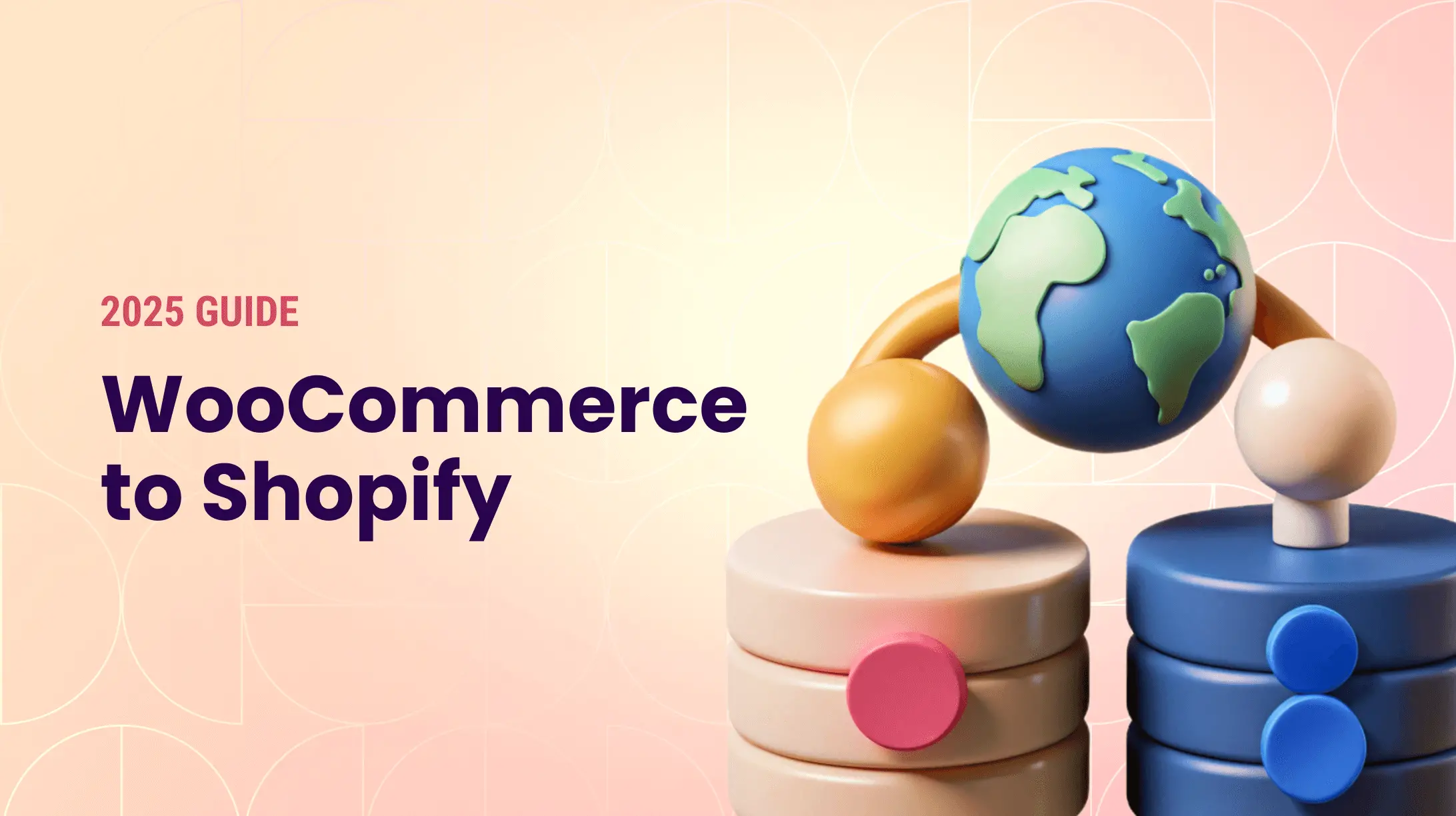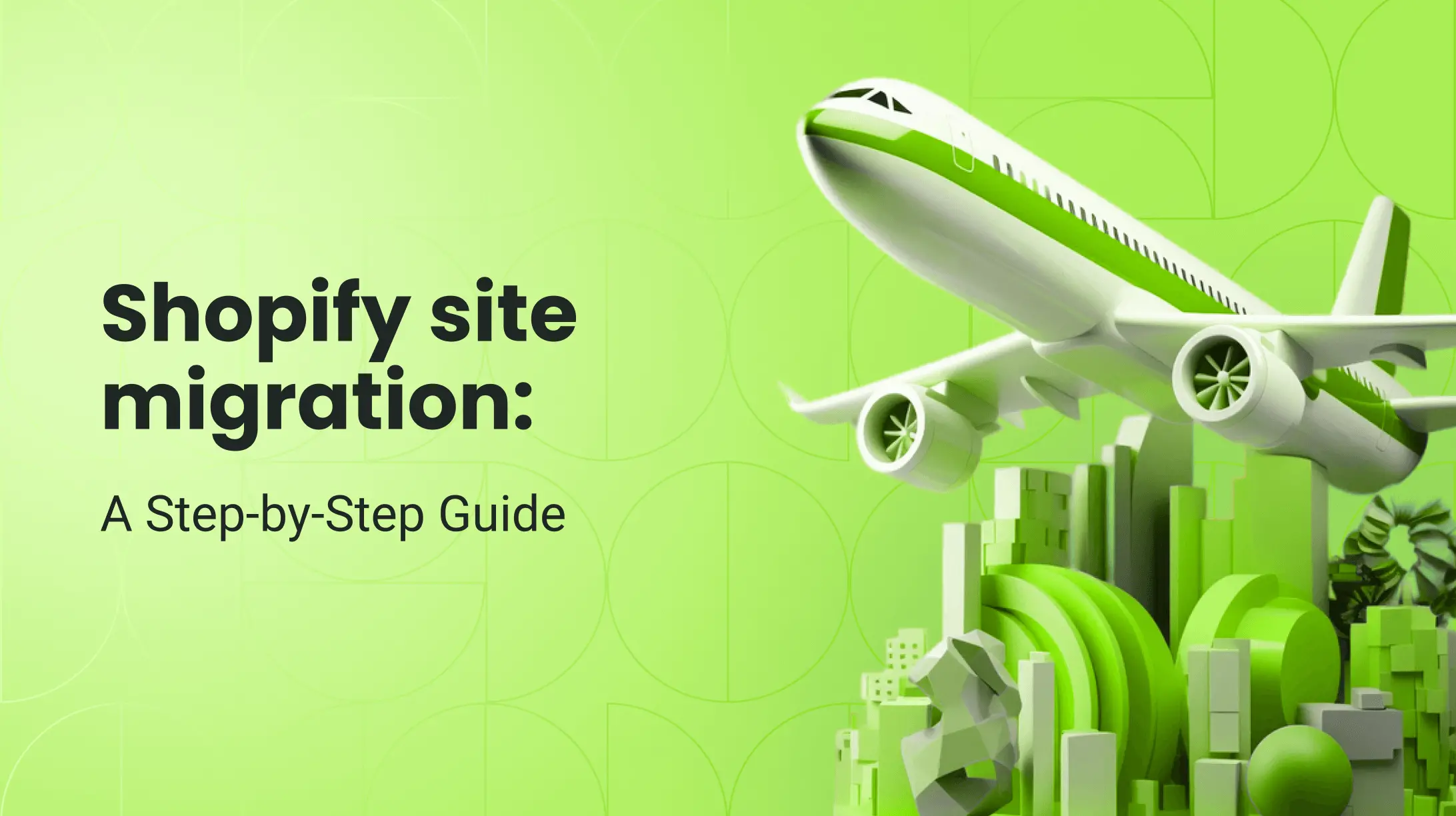0%

In This Article:
Why Migrate from WooCommerce to Shopify?
Getting Ready for WooCommerce to Shopify Migration
Third-Party Tools for WooCommerce to Shopify Migration
Step-by-Step WooCommerce to Shopify Migration Process
Post-Migration Tasks & Customizing
How to Retain SEO Rankings and Optimize Marketing Strategies?
Real-World WooCommerce to Shopify Migration Case Studies
Common Migration Challenges and How to Overcome Them
FAQs
WooCommerce powers approximately 20.1% of all online stores, ranking second behind Shopify, which holds around 26.2%. The statistics alone show that, even despite WooCommerce’s free installation, more businesses prefer the paid option of Shopify.
Why is that? While WooCommerce offers extensive customization, its scalability issues – along with the need for more hands-on management – can hinder growth. In contrast, Shopify provides a user-friendly, all-in-one platform that can easily scale along with your business. Eventually, companies pursuing growth end up moving their WooCommerce stores to Shopify.
This article presents a comprehensive guide to facilitate a smooth transition from WooCommerce to Shopify, tackling common issues and ensuring a seamless migration process to enhance your business's potential.
Why Migrate from WooCommerce to Shopify?
Here's a comparison of why migrating from WooCommerce to Shopify can be beneficial for your business:
| Aspect | WooCommerce | Shopify |
| Ease of Use | Requires technical skills for setup and management | Intuitive interface with easy store management |
| Security and Reliability | Self-hosted, requiring manual updates and security checks | Hosted solution with automatic security updates |
| Integrated PaymentOptions | Limited built-in options, often requires add-ons | Extensive payment gateways with competitive transaction fees |
| App Ecosystem | Plugins available, often requiring manual updates | Vast app store with seamless integrations and automatic updates |
| Support | Community support with limited options | 24/7 customer support with responsive assistance |
| Scalability | Can become complex with growth | Scalable features to support business expansion and manage high traffic efficiently |

Even though migrating can be challenging, moving from WooCommerce to Shopify is a smart decision for businesses wanting a dependable, easy-to-use platform. With strong security, a wide range of apps, and 24/7 support, Shopify helps your business run smoothly and grow, making it a great choice for the future.
Getting Ready for WooCommerce to Shopify Migration
Thorough preparation always ensures a smooth and successful transition. Here's a detailed guide to help you get ready for the migration process:
Back Up Data
Ensure you have a secure backup of all current data. This includes customer information, order history, product details, and any custom features. Use reliable backup tools or services to safeguard against data loss during migration.
Analyze Store Structure
Document your existing store layout, including categories, page structures, and navigation. Understanding your current setup will help in recreating or improving upon it in Shopify. Note special functionalities and customizations you may need to replicate.
Evaluate Apps and Plugins
Make a detailed list of all WooCommerce plugins currently in use. Evaluate which ones you need most and research equivalent Shopify apps to ensure a smooth WordPress to Shopify migration.
Prepare Store Data for Migration
Before you export products, product categories, customers, and other data you have on your WooCommerce store, carefully review each data set:
- Products – Ensure all product information is ready for transfer. This includes descriptions, pricing, product images, SKUs, categories, and any tags or attributes. Verify that all data fields align with Shopify’s requirements for a smooth import.
- Customers – Prepare customer data, including names, contact information, purchase history, and preferences. Consider how these data points will map to Shopify’s customer system to maintain continuity in customer accounts and communications.
- Orders – Compile a comprehensive record of all past orders, including status and transaction details. Plan for how order data will be managed within Shopify’s ecosystem.
- Inventory Levels – Check current stock levels for accuracy and update them as needed. This will ensure that your inventory management in Shopify reflects up-to-date product availability.
- User Accounts and Roles – Identify existing user accounts and roles within your WooCommerce store. Plan how these roles will translate to Shopify’s user permissions to maintain necessary access controls.
- SEO Settings – Assess important SEO settings such as meta titles, descriptions, and URL structures. Develop a plan to implement these in Shopify to help preserve search engine rankings post-migration.
Third-Party Tools for WooCommerce to Shopify Migration
Leveraging third-party tools can simplify the migration process from WooCommerce to Shopify. Here's a detailed look at popular tools and how to choose the right one for your business needs:
Сomparison Table of Popular Migration Tools
| Feature | Shopify’s Import Tool | Cart2Cart | LitExtension |
| Ease of Use | Simple, ideal for basic imports | Intuitive interface | User-friendly with detailed tutorials |
| Data Accuracy | Basic data import with CSV files | High accuracy with comprehensive data | Precise mapping of complex attributes |
| Support | Limited support for complex issues | Extensive support and assistance | Exceptional customer support |
| Customization | Limited to CSV file configurations | Customizable migration options | Advanced mapping and customization |
| Cost | Cost-effective for smaller stores | Based on data volume | Charged per data volume migrated |
| Demo Migration | Not applicable | Available for trial | Available for visual walkthrough |
| SEO Settings | Limited SEO handling capabilities | Retains existing SEO configurations | Advanced SEO migration support |
Factors Affecting Your Choice
- Size of Business – Evaluate the size of your inventory and data volume. Larger businesses with complex datasets may benefit more from comprehensive tools like Cart2Cart or LitExtension, which handle intricate details and provide robust support.
- Budget Considerations – Consider the cost of each service in relation to the features and support offered. Cart2Cart and LitExtension typically charge based on the volume of data, while Shopify’s import tool may be more budget-friendly for smaller businesses with simpler needs.
- Data Complexity – Assess the complexity of your data, including custom fields, order histories, and SEO settings. Tools like LitExtension offer advanced mapping and customization that are necessary for intricate migrations.
- Support and Assistance – Consider the level of support you might need. If you prefer hands-on guidance, choose a tool known for excellent customer service and support availability, such as LitExtension.
Get in touch
with our expert
Discuss your project requirements and get a free estimate.
Get in touch
with our expert
Discuss your project requirements and get a free estimate.
Step-by-Step WooCommerce to Shopify Migration Process
Successfully transferring from WooCommerce to Shopify requires careful planning and execution. Here’s a detailed step-by-step process to guide you through a seamless transition:
1. Set Up Your Shopify Account
Begin by signing up for a Shopify account. Choose a plan that fits your business needs and configure basic settings such as currency, language, and payment processors. Familiarize yourself with the Shopify dashboard and explore the available themes and apps.
2. Export Data from WooCommerce
Leverage WooCommerce’s built-in export functionality or a plugin like “WP All Export” to extract your data. Ensure you export all necessary data, including products, customers, orders, and any custom fields you might have used.
3. Import Data into Shopify
Use Shopify’s native import tool or a third-party app for data migration. Carefully follow the prompts to import products, customer data, and order history. Pay attention to data mapping to maintain consistency.
Post-Migration Tasks & Customizing
After migrating from WooCommerce to Shopify, ensure everything is set up correctly to maintain seamless operations. Here are the key tasks you need to undertake:
Verify Data Integrity
Conduct a thorough review of all migrated data. Cross-check products, customer information, and order histories to ensure nothing was lost or altered during the migration. Utilize Shopify’s reporting tools to verify data accuracy and completeness.
Conduct Functional Testing
Perform comprehensive testing of all store functionalities. This includes:
- Checkout Process – Test different payment gateways and scenarios.
- Customer Accounts – Ensure login, registration, and profile management all function properly.
- Search and Filter Options – Verify these features work as expected for seamless navigation.
- App Integrations – Check that all integrated apps are functioning and configured correctly.
Align Design with Brand Identity
Select a Shopify theme that best reflects your brand’s aesthetics. Use the theme editor to customize elements such as fonts, colors, and layouts, ensuring consistency with your existing brand identity.
Customize Navigation and Product Pages
Improve user experience by refining the navigation structure. Organize categories logically and ensure that product pages are informative and appealing:
- Navigation – Create intuitive menus that guide users smoothly throughout the site.
- Product Pages – Enhance with high-quality images, detailed descriptions, and upsell or cross-sell features.
How to Retain SEO Rankings and Optimize Marketing Strategies?
Properly adapting your SEO and marketing strategies to Shopify is key to recovering SEO rankings and maintaining your store’s visibility and customer engagement. Follow these steps to ensure optimal performance:
- Implement 301 Redirects – Use Shopify’s URL redirect feature to redirect old URLs to new ones, maintaining SEO value and preventing broken links.
- Optimize Metadata – Update meta titles, descriptions, and alt tags using Shopify’s SEO tools to align with best practices.
- Audit Internal Links – Check and update internal links to ensure they point to the correct URLs, preserving site architecture.
- Integrate Analytics – Set up Google Analytics and other tracking tools anew, ensuring correct e-commerce tracking and linking to Google Search Console.
- Check Site Speed – Utilize Shopify’s built-in tools or third-party apps to analyze and optimize site performance for better SEO and user experience.
- Monitor Backlinks – Ensure existing backlinks lead to the new URLs, maintaining SEO juice. Reach out to partners for updates if necessary.
- Leverage Social Media Integration – Use Shopify’s social media tools to seamlessly connect and promote your store across platforms, boosting visibility.
Real-World WooCommerce to Shopify Migration Case Studies
These successful Shopify migration examples highlight how businesses have transformed their operations, improved customer experiences, and achieved remarkable results after migrating from WooCommerce.
CarBahn Autoworks
CarBahn Autoworks faced operational inefficiencies and a fragmented customer experience while managing three separate WooCommerce sites. To streamline operations and improve user journeys, the brand migrated to Shopify. With enhanced site navigation, integrated tools like a vehicle fitment search and store locator, and a unified backend, CarBahn saw significant improvements in usability and performance.
Results after migrating to Shopify:
- Organic traffic tripled within 30 days
- Order count tripled
- Average order value increased by over $200
- Load times dropped from 9 seconds to 1 second
- Return and cancellation rates decreased by 43%, reaching the lowest in company history
The Skin Nerd
The Skin Nerd, a rapidly growing skin care consultancy and e-commerce business, faced technical limitations and rising operational costs on WooCommerce. Seeking better site performance, scalability, and cost efficiency, the company migrated to Shopify. The move allowed them to simplify their tech stack, improve site speed, and eliminate reliance on custom development.
Results after migrating to Shopify:
- Average page load time reduced from 9 seconds to under 2 seconds
- 19% boost in conversions
- 10x increase in sales during the 2020 peak
- $10,000 saved annually on app costs
- $35,000 saved annually on developer fees
E. Marinella
Marinella, a prestigious luxury brand known for its handcrafted Italian ties and accessories, faced scalability issues and limited e-commerce capabilities on their previous platform. Seeking to expand their global reach and enhance the online shopping experience, the company migrated to Shopify. The move allowed them to utilize a more robust and flexible platform that catered to their unique needs.
Results after migrating to Shopify:
- 40% surge in global sales within the first year
- 50% increase in website load speeds
- 30% boost in mobile sales due to optimized mobile experience
- 25% reduction in stock errors through streamlined inventory management
- Seamless expansion into several international markets
Common Migration Challenges and How to Overcome Them
- Data Loss – Before migrating, ensure data compatibility between WooCommerce and Shopify by mapping your data fields correctly. Conduct trial runs with small data sets to identify potential issues, and always keep a backup.
- Design Adjustments – Prepare for some redesign as Shopify and WooCommerce have different theme structures. Choose a Shopify theme that closely aligns with your existing design or customize it using Shopify’s Liquid template language and theme editor for consistency.
- Maintaining SEO – Ensure all URLs and metadata are correctly mapped to avoid losing SEO rankings. Use Shopify’s URL redirect feature to manage any changes in URLs.
- App Integration – Review the apps and plugins used in WooCommerce and seek equivalent Shopify apps. This ensures functionality is retained or improved in the new store environment.
Final Thoughts: Switch from WooCommerce to Shopify
Converting WooCommerce to Shopify can transform your e-commerce operations and offer improved scalability, security, and user experience. By understanding this migration process and utilizing the right tools, you can ensure a smooth transition that enhances customer satisfaction and drives sales growth.
Even if the process seems daunting, you don't have to tackle it alone. Leverage our WooCommerce to Shopify migration services to ensure your store is optimized for success from day one.
FAQs
Can you migrate from WooCommerce to Shopify?
Yes, migrating from WooCommerce to Shopify is feasible and often straightforward with the right tools and planning. Following a structured process ensures data integrity and minimizes downtime.
Why use Shopify instead of WooCommerce?
Shopify offers a user-friendly interface, robust security, integrated payment options, and a vast app ecosystem, making it ideal for businesses seeking scalability and ease of management.
How long does the migration process take?
The duration of migration can vary based on the size of your store and the complexity of data. Generally, it ranges from a few days to a couple of weeks.
Will my SEO be affected during the migration?
By implementing strategic measures such as 301 redirects and metadata optimization, you can minimize any negative impact on your SEO rankings during the migration.
Alex excels in creating and approving customization architecture, ensuring robust and efficient solutions for e-commerce platforms. His expertise in Magento allows him to effectively manage tech resources and drive technical projects to successful completion.
Alex excels in creating and approving customization architecture, ensuring robust and efficient solutions for e-commerce platforms. His expertise in Magento allows him to effectively manage tech resources and drive technical projects to successful completion.



